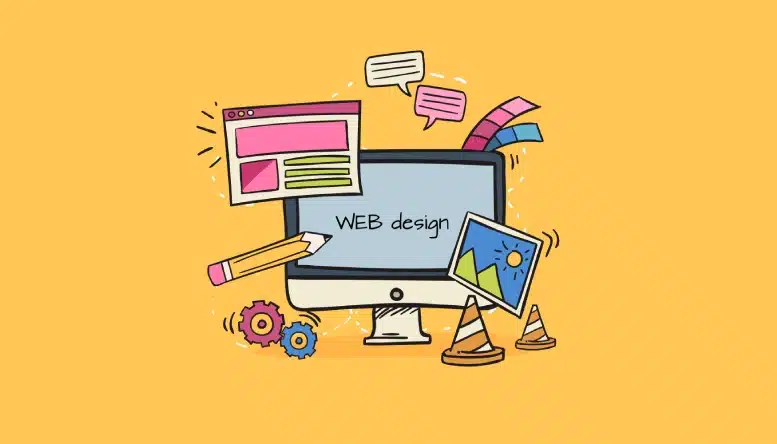Exploring Creative Trends in Web Design for Modern Businesses
The landscape of web design is consistently evolving, reflecting the vibrant needs of modern-day businesses. Current trends highlight a choice for minimalism, strong typography, and appealing interactivity. Companies progressively focus on user experience through mobile-first concepts and personalized material. Furthermore, a concentrate on sustainability is acquiring grip. Recognizing these trends is vital for services aiming to stick out in a congested industry. What effects do these shifts hold for the future of digital involvement?
Accepting Strong Typography
Bold typography has actually emerged as a specifying aspect in contemporary web design, catching attention and conveying messages with striking clarity. This trend focuses on visually impactful message that boosts user involvement and brand identification. Designers typically make use of extra-large font styles and distinct typefaces to create a pecking order, directing audiences through web content seamlessly.
The strategic usage of bold typography permits reliable narration, making it possible for brands to interact their values succinctly. It serves not just visual purposes yet additionally useful ones, as it improves readability across gadgets and display sizes.
As websites contend for user attention, strong typography stands apart in a saturated digital landscape. Its convenience enables developers to trying out contrasting shades and layouts, further magnifying its effectiveness. Inevitably, embracing bold typography represents a shift towards even more communicative and meaningful web design, cultivating a much deeper connection between brand names and their audiences.
The Increase of Minimalist Style
As electronic settings become progressively messy, the increase of minimalist layout provides an invigorating choice that prioritizes simpleness and functionality. This layout approach remove unneeded components, allowing content to take facility phase. By concentrating on tidy lines, ample white area, and a restricted shade palette, minimalist design improves user experience and improves navigation.
Services adopting this pattern purpose to share their brand message plainly and efficiently, promoting a feeling of calmness and clearness. The absence of distractions helps users concentrate on necessary info, bring about boosted involvement and conversion prices. Furthermore, minimal style aligns well with mobile-first approaches, making certain that websites remain easy to use and accessible throughout different gadgets.
Ultimately, the surge of minimal design shows a wider shift towards focusing on user demands and preferences, making it an effective tool for contemporary companies wanting to make a lasting influence in the electronic landscape.
Immersive Animations and Interactivity
While many web designers welcome minimalist appearances, one more engaging fad getting traction is the usage of immersive animations and interactivity. This approach enhances user involvement by creating interesting experiences that draw site visitors into the content. Designers utilize vibrant elements such as computer animated histories, scrolling effects, and interactive infographics to connect complicated concepts in an accessible manner.
These computer animations not just offer aesthetic rate of interest yet also overview customers with the navigating process, making interactions extra instinctive. Float effects and animated changes can encourage customers to check out even more, leading to raised time invested on the website.
This pattern aligns with the broader motion towards storytelling in internet design, where animations serve as narrative tools that share brand name messages successfully. By integrating immersive animations and interactivity, companies can separate themselves in a crowded online landscape, eventually improving user contentment and brand loyalty.
Mobile-First Layout Principles
Mobile-first design principles emphasize focusing on user experience by making certain websites work seamlessly on smaller screens. This approach integrates receptive design strategies that adapt to various tool dimensions while preserving visual stability. Additionally, it concentrates on touchscreen navigating design, improving usability for mobile individuals.
Prioritizing User Experience
Just how can developers successfully focus on user experience in an increasingly mobile-centric world? Highlighting mobile-first layout principles is crucial, as individuals primarily involve with websites with mobile phones. This strategy urges designers to streamline content, ensuring it is navigable and easily available on smaller sized screens. Key practices consist of simplifying navigating, lessening load times, and employing touch-friendly elements that improve interactivity. In addition, focusing on readable typography and instinctive designs can considerably improve user complete satisfaction. Designers need to continuously gather user comments to improve their methods, adapting to developing user requirements and choices. By concentrating on these components, services can create an engaging digital experience that fosters commitment and drives conversions, eventually lining up with the expectations of today's mobile individuals.
Responsive Design Methods
Developers embrace responsive design methods to create flexible and flexible internet experiences that provide to numerous display sizes. This technique focuses on mobile-first layout principles, making certain peak capability on smaller sized tools prior to scaling up for larger displays. By making use of liquid grids, flexible photos, and media inquiries, developers can preserve a cohesive aesthetic identity across all systems. This approach not just improves user engagement however also boosts search engine rankings, as mobile-friendly websites are favored by search formulas. In addition, responsive formats enable organizations to get to a more comprehensive audience, accommodating users on tablet computers, smartphones, and desktop computers alike. On the whole, applying these methods is essential for contemporary web design, guaranteeing that organizations continue to be affordable in an ever-evolving electronic landscape.
Touchscreen Navigating Style
With the look at here now rise of mobile phones, touchscreen navigating has actually become a fundamental element of web design. Designers are increasingly embracing mobile-first principles to boost user experience and engagement. Web Design Agency. Reliable touchscreen navigating prioritizes bigger switches our website and user-friendly gestures, permitting users to communicate easily with web content. This technique reduces frustration and motivates expedition, as users can navigate effortlessly with their fingers. Additionally, integrating swipe motions and tap performance deals with the all-natural habits of mobile customers. Comments devices, such as visual cues and animations, boost functionality further by validating activities. As touchscreens control user communications, using these layout aspects not just aligns with contemporary assumptions however likewise fosters a much more satisfying and easily accessible surfing experience for all customers
Customized User Experiences
What makes a customer feel truly involved on a website? The answer often hinges on customized user experiences. By customizing content and navigation to specific preferences, companies can develop a purposeful connection with their target market. This customization can be achieved with numerous techniques, such as examining user behavior, using cookies, and using tailored suggestions based upon previous communications.
Ecommerce platforms that recommend products based on searching history not just boost user experience however likewise raise conversion rates. Furthermore, including dynamic material that adapts to the user's area or time of day can additionally enhance interaction.
Furthermore, tailored greetings or messages can make customers really feel valued and recognized. As modern-day services venture to attract attention in a competitive digital landscape, embracing individualized user experiences ends up being necessary, cultivating loyalty and motivating repeat sees. Inevitably, this method transforms a conventional web site right into an interactive platform that reverberates with its target market.
Sustainability in Web Design
As the electronic landscape proceeds to advance, the relevance of sustainability in web design has actually browse around these guys gotten substantial focus. Developers are significantly mindful of the environmental effect their developments can have, motivating a shift towards environmentally friendly practices (Website Design Agency). Sustainable web design concentrates on maximizing web sites to lower energy intake and carbon impacts. Strategies include making use of minimalistic layout concepts, optimizing images, and using effective coding techniques to improve loading speeds
Additionally, the option of holding providers plays an important duty; several designers are currently selecting environment-friendly organizing solutions powered by renewable power. By focusing on ease of access and straightforward navigation, lasting styles likewise accommodate a wider audience, boosting functionality. This mindful strategy not just appeals to environmentally-minded customers but also adds to the overall durability and efficiency of web sites. Eventually, sustainability in web design mirrors a growing pattern in the direction of accountable digital techniques that straighten with modern organization values.

Regularly Asked Questions
Exactly How Can I Select the Right Color Design for My Web site?
To choose the best color system for a site, one need to think about the brand name's identity, target audience, and emotional influence. Utilizing color theory and testing combinations can improve user experience and visual allure substantially.
What Are the most effective Tools for Prototyping Internet Layouts?
The ideal devices for prototyping website design consist of Figma, Map out, Adobe XD, and InVision. These systems supply instinctive interfaces, cooperation attributes, and comprehensive libraries, making them ideal for developers to produce and fine-tune their concepts efficiently.
How Do I Measure the Effectiveness of My Web Design?
To measure web design effectiveness, one need to evaluate user involvement metrics, conversion rates, and use comments (Web Design Agency). A/B screening and heatmaps can also supply insights into user behavior, leading required changes for better performance and user experience
What Are Common Web Design Blunders to Stay Clear Of?
Typical web design mistakes consist of cluttered designs, inadequate navigation, slow filling times, lack of mobile optimization, insufficient contrast, and ignoring user responses. Preventing these risks enhances user experience and boosts general efficiency of the web site.
Exactly how Often Should I Update My Site Design?
A website style should be updated every a couple of years, or earlier if substantial modifications in branding or innovation occur. Normal updates keep the website fresh, practical, and aligned with current user expectations.
